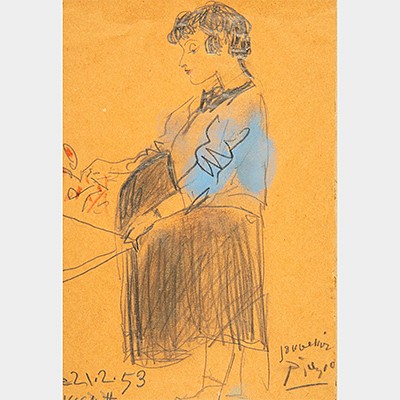SALVADOR DALÍ I DOMÈNECH (Figueras, Girona, 1904 - 1989). "Nude Woman climbing the stairs", 1974. Sculpture in 18kt yellow gold on a silver pedestal.
Lot 55
About Seller
Setdart Auction House
Carrer Aragó 346
Barcelona
Spain
Setdart Subastas was born in 2004 and is currently the first online art auction in Spain with solidity, prestige and reliability guaranteed by our more than 60,000 users. Setdart has a young, dynamic and enterprising team ready to successfully manage the purchase and sale of art works through custom...Read more
Categories
Estimate:
EUR€7,000 - EUR€8,000
$7,368.42 - $8,421.05
Absentee vs Live bid
Two ways to bid:
- Leave a max absentee bid and the platform will bid on your behalf up to your maximum bid during the live auction.
- Bid live during the auction and your bids will be submitted real-time to the auctioneer.
Bid Increments
| Price | Bid Increment |
|---|---|
| EUR€0 | EUR€10 |
| EUR€200 | EUR€25 |
| EUR€500 | EUR€50 |
| EUR€1,000 | EUR€100 |
| EUR€3,000 | EUR€200 |
| EUR€5,000 | EUR€500 |
| EUR€10,000 | EUR€1,000 |
| EUR€20,000 | EUR€2,000 |
| EUR€50,000 | EUR€5,000 |
About Auction
By Setdart Auction House
Sep 20, 2021
Set Reminder
2021-09-20 08:00:00
2021-09-20 08:00:00
America/New_York
Bidsquare
Bidsquare : CONTEMPORARY ART
https://www.bidsquare.com/auctions/setdart-auction-house/contemporary-art-7482
Setdart Auction House sofia@setdart.com
Setdart Auction House sofia@setdart.com
- Lot Description
SALVADOR DALÍ I DOMÈNECH (Figueras, Girona, 1904 - 1989). "Nude Woman climbing the stairs", 1974. Sculpture in 18kt yellow gold on a silver pedestal. Exemplary A-234. Print run of 300 copies. Signed, dated and justified. Measures: 13,5 x 9 x 11 cm. Certificate of authenticity enclosed. We are in front of a sculpture made in 1974 by Salvador Dalí in which a nude woman climbing a staircase is represented, made in 18 carat yellow gold on a silver pedestal. The theme of "Naked Woman Climbing the Stairs" has been a recurring theme in the work of artists such as Miró, who produced a pencil and charcoal drawing on the same subject in March 1937. It could also be a tribute to Marcel Duchamp, who in 1912 produced a series of paintings on the model of "Nude Woman Descending a Staircase", this work is considered a modernist classic and has become one of the most famous of its time. When it was first shown at the Salon des Indépendants in Paris, it was rejected by the Cubists and caused a great stir during its exhibition at the 1913 Armory Show in New York. The work is now on permanent display in the collection of Luis and Walter Arensberg at the Philadelphia Museum of Art in Philadelphia. Salvador Dalí, the quintessential Surrealist artist, depicts in this sculpture the image of a young woman climbing a staircase, which is a conch shell. In his early years, Dalí discovered contemporary painting during a family visit to Cadaqués, where he met the family of Ramon Pichot, an artist who travelled regularly to Paris. Following Pichot's advice, Dalí began to study painting with Juan Núñez. In 1922, Dalí stayed at the famous Residencia de Estudiantes in Madrid to begin studying Fine Arts at the San Fernando Academy. However, before his final exams in 1926, he was expelled for claiming that there was no one there fit to examine him. That same year Dalí travelled to Paris for the first time. There he met Picasso, and established certain formal characteristics that were to become the hallmark of all his work from then on. During this period Dalí held regular exhibitions in both Barcelona and Paris, and joined the Surrealist group based in the Parisian district of Montparnasse. The painter landed in America in 1934, thanks to the art dealer Julian Levy. Following his first solo exhibition in New York his international reputation was definitively consolidated, and from then on he exhibited his work and gave lectures all over the world. Most of his production is housed in the Dalí Theatre-Museum in Figueras, followed by the collection of the Salvador Dalí Museum in St. Petersburg (Florida), the Reina Sofía in Madrid, the Salvador Dalí Gallery in Pacific Palisades (California), the Espace Dalí in Montmartre (Paris) and the Dalí Universe in London.
- Shipping Info
-
In-house shipping available. Please inquire at admin@setdart.com.
-
- Buyer's Premium



 EUR
EUR CAD
CAD AUD
AUD GBP
GBP MXN
MXN HKD
HKD CNY
CNY MYR
MYR SEK
SEK SGD
SGD CHF
CHF THB
THB


















